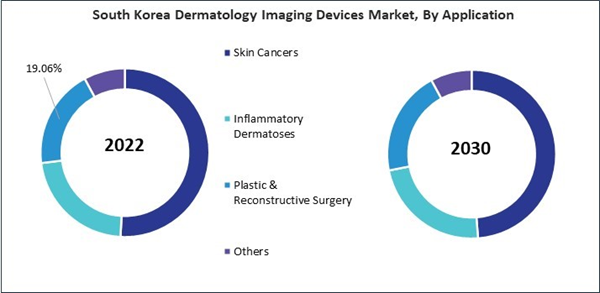The China market dominated the Asia Pacific Dermatology Imaging Devices Market by Country in 2022, and would continue to be a dominant market till 2030; thereby, achieving a market value of $382.4 million by 2030. The Japan market exhibiting a CAGR of 12.6% during (2023 - 2030). Additionally, The India market would experience a CAGR of 14.1% during (2023 - 2030).
Dermatology imaging devices, such as dermatoscopes and reflectance confocal microscopes, are instrumental in the early detection of skin cancers. They enable healthcare professionals to closely examine moles, lesions, and pigmented areas, aiding in the identification of potential malignancies like melanoma. Early detection is critical for successful intervention and improved outcomes in skin cancer cases. These devices assist in distinguishing between benign and malignant skin lesions. Dermatoscopes, for example, provide magnified views of skin structures, helping dermatologists analyze patterns and textures that may indicate the nature of the lesion. Accurate differentiation is essential for determining the appropriate action, whether monitoring, biopsy, or immediate treatment.
Dermatology imaging devices are used to monitor the progress of dermatological treatments. By capturing images at various stages of treatment, healthcare professionals can objectively assess the effectiveness of interventions. This facilitates timely treatment plan adjustments, ensuring patients receive personalized and optimized care. It provides valuable insights into chronic skin conditions such as psoriasis, eczema, and dermatitis. Additionally, in numbers, about 223 million people affected by atopic dermatitis in 2022 (GBD 2022), approximately 43 million are aged 1-4.
The growing recognition of geriatric dermatology as a specialized field emphasizes the unique dermatological needs of the aging population in China. It is integral to geriatric dermatology practices, enabling comprehensive skin assessments in China. The aging population in China is becoming more aware of dermatological health, leading to increased patient demand for specialized care. Expanding healthcare infrastructure in China, including senior care facilities, provides opportunities to integrate dermatology imaging devices. By 2045, the United Nations estimates that approximately 450 million individuals in China will be 60 or older. Therefore, due to the above-mentioned factors, the market will grow significantly in this region.
Based on End-use, the market is segmented into Hospitals, Dermatology Centers, and Specialty Clinics. Based on Modality, the market is segmented into Dermatoscope, Digital Photographic Imaging, Optical Coherence Tomography (OCT), High Frequency Ultrasound, and Others. Based on Application, the market is segmented into Skin Cancers, Inflammatory Dermatoses, Plastic & Reconstructive Surgery, and Others. Based on countries, the market is segmented into China, Japan, India, South Korea, Singapore, Malaysia, and Rest of Asia Pacific.
List of Key Companies Profiled
- GE HealthCare Technologies, Inc.
- Koninklijke Philips N.V.
- Canfield Scientific, Inc.
- FotoFinder Systems GmbH
- Courage + Khazaka electronic GmbH
- FUJIFILM VisualSonics, Inc. (Fujifilm Holdings Corporation)
- Longport, Inc.
- Michelson Diagnostics Ltd
- DRAMINSKI S. A.
- Cortex Technology ApS
Market Report Segmentation
By End-use- Hospitals
- Dermatology Centers
- Specialty Clinics
- Dermatoscope
- Digital Photographic Imaging
- Optical Coherence Tomography (OCT)
- High Frequency Ultrasound
- Others
- Skin Cancers
- Inflammatory Dermatoses
- Plastic & Reconstructive Surgery
- Others
- China
- Japan
- India
- South Korea
- Australia
- Malaysia
- Rest of Asia Pacific
Table of Contents
Companies Mentioned
- GE HealthCare Technologies, Inc.
- Koninklijke Philips N.V.
- Canfield Scientific, Inc.
- FotoFinder Systems GmbH
- Courage + Khazaka electronic GmbH
- FUJIFILM VisualSonics, Inc. (Fujifilm Holdings Corporation)
- Longport, Inc.
- Michelson Diagnostics Ltd
- DRAMINSKI S. A.
- Cortex Technology ApS









